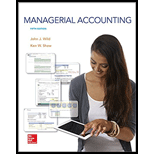
MANAGERIAL ACCOUNTING FUND. W/CONNECT
5th Edition
ISBN: 9781259688713
Author: Wild
Publisher: MCG
expand_more
expand_more
format_list_bulleted
Textbook Question
Chapter 4, Problem 3QS
Plant wide rate method P1
A manufacturer uses machine hours to assign
| Budgeted |
$544,000 |
| Budgeted machine hours ……………………………………………………………………… | 6,400 |
Expert Solution & Answer
Want to see the full answer?
Check out a sample textbook solution
Students have asked these similar questions
I am looking for help with this financial accounting question using proper accounting standards.
I am looking for help with this general accounting question using proper accounting standards.
Please provide the correct answer to this financial accounting problem using accurate calculations.
Chapter 4 Solutions
MANAGERIAL ACCOUNTING FUND. W/CONNECT
Ch. 4 - Prob. 1MCQCh. 4 - Prob. 2MCQCh. 4 - All of the following are examples of batch-level...Ch. 4 - Prob. 4MCQCh. 4 - Prob. 5MCQCh. 4 - Why are overhead costs allocated to products and...Ch. 4 - What are three common methods of assigning...Ch. 4 - Why are direct labor hours and machine hours...Ch. 4 - What are the advantages of using a single plant...Ch. 4 - The usefulness of a single plant wide overhead...
Ch. 4 - What is a cost object?Ch. 4 - Explain why a single plantwide overhead rate can...Ch. 4 - Why are multiple departmental overhead rates more...Ch. 4 - Prob. 9DQCh. 4 - Prob. 10DQCh. 4 - Prob. 11DQCh. 4 - Prob. 12DQCh. 4 - Prob. 13DQCh. 4 - Prob. 14DQCh. 4 - 15. What are the four activity levels associated...Ch. 4 - Prob. 16DQCh. 4 - Prob. 17DQCh. 4 - Prob. 1QSCh. 4 - Prob. 2QSCh. 4 - Plant wide rate method P1 A manufacturer uses...Ch. 4 - Prob. 4QSCh. 4 - Prob. 5QSCh. 4 - Prob. 6QSCh. 4 - Prob. 7QSCh. 4 - Prob. 8QSCh. 4 - Prob. 9QSCh. 4 - Prob. 10QSCh. 4 - Prob. 11QSCh. 4 - Prob. 12QSCh. 4 - Prob. 13QSCh. 4 - Prob. 14QSCh. 4 - Prob. 15QSCh. 4 - Prob. 1ECh. 4 - Prob. 2ECh. 4 - Prob. 3ECh. 4 - Prob. 4ECh. 4 - Prob. 5ECh. 4 - Prob. 6ECh. 4 - Prob. 7ECh. 4 - Prob. 8ECh. 4 - Refer to the information in Exercise 4-7 to answer...Ch. 4 - Consider the following date for two products of...Ch. 4 - Prob. 11ECh. 4 - Prob. 12ECh. 4 - Prob. 13ECh. 4 - Exerciser 17-14 Activity-based costing P3 A2...Ch. 4 - Prob. 15ECh. 4 - Prob. 16ECh. 4 - Prob. 17ECh. 4 - Prob. 18ECh. 4 - Prob. 1PSACh. 4 - Prob. 2PSACh. 4 - Prob. 3PSACh. 4 - Prob. 4PSACh. 4 - Prob. 5PSACh. 4 - Prob. 1PSBCh. 4 - Prob. 2PSBCh. 4 - Ryan Foods produces gourmet gift baskets that it...Ch. 4 - Prob. 4PSBCh. 4 - Prob. 5PSBCh. 4 - Prob. 4SPCh. 4 - Prob. 1BTNCh. 4 - Prob. 2BTNCh. 4 - Prob. 3BTNCh. 4 - Prob. 4BTNCh. 4 - Accounting professionals who for private companies...Ch. 4 - Prob. 6BTNCh. 4 - Prob. 7BTNCh. 4 - Prob. 8BTNCh. 4 - Prob. 9BTN
Knowledge Booster
Learn more about
Need a deep-dive on the concept behind this application? Look no further. Learn more about this topic, accounting and related others by exploring similar questions and additional content below.Similar questions
- I am searching for the right answer to this financial accounting question using proper techniques.arrow_forwardPlease help me solve this financial accounting question using the right financial principles.arrow_forwardCan you solve this financial accounting problem with appropriate steps and explanations?arrow_forward
- Can you show me the correct approach to solve this financial accounting problem using suitable standards?arrow_forwardI am looking for help with this general accounting question using proper accounting standards.arrow_forwardI need assistance with this financial accounting problem using valid financial procedures.arrow_forward
- Please provide the correct answer to this general accounting problem using accurate calculations.arrow_forwardPlease provide the correct answer to this general accounting problem using accurate calculations.arrow_forwardI am looking for a step-by-step explanation of this financial accounting problem with correct standards.arrow_forward
- Can you solve this general accounting problem with appropriate steps and explanations?arrow_forwardI need help with this financial accounting question using standard accounting techniques.arrow_forwardCould you help me solve this financial accounting question using appropriate calculation techniques?arrow_forward
arrow_back_ios
SEE MORE QUESTIONS
arrow_forward_ios
Recommended textbooks for you
- Principles of Accounting Volume 2AccountingISBN:9781947172609Author:OpenStaxPublisher:OpenStax College
 Managerial Accounting: The Cornerstone of Busines...AccountingISBN:9781337115773Author:Maryanne M. Mowen, Don R. Hansen, Dan L. HeitgerPublisher:Cengage Learning
Managerial Accounting: The Cornerstone of Busines...AccountingISBN:9781337115773Author:Maryanne M. Mowen, Don R. Hansen, Dan L. HeitgerPublisher:Cengage Learning Essentials of Business Analytics (MindTap Course ...StatisticsISBN:9781305627734Author:Jeffrey D. Camm, James J. Cochran, Michael J. Fry, Jeffrey W. Ohlmann, David R. AndersonPublisher:Cengage Learning
Essentials of Business Analytics (MindTap Course ...StatisticsISBN:9781305627734Author:Jeffrey D. Camm, James J. Cochran, Michael J. Fry, Jeffrey W. Ohlmann, David R. AndersonPublisher:Cengage Learning  Survey of Accounting (Accounting I)AccountingISBN:9781305961883Author:Carl WarrenPublisher:Cengage Learning
Survey of Accounting (Accounting I)AccountingISBN:9781305961883Author:Carl WarrenPublisher:Cengage Learning

Principles of Accounting Volume 2
Accounting
ISBN:9781947172609
Author:OpenStax
Publisher:OpenStax College

Managerial Accounting: The Cornerstone of Busines...
Accounting
ISBN:9781337115773
Author:Maryanne M. Mowen, Don R. Hansen, Dan L. Heitger
Publisher:Cengage Learning

Essentials of Business Analytics (MindTap Course ...
Statistics
ISBN:9781305627734
Author:Jeffrey D. Camm, James J. Cochran, Michael J. Fry, Jeffrey W. Ohlmann, David R. Anderson
Publisher:Cengage Learning

Survey of Accounting (Accounting I)
Accounting
ISBN:9781305961883
Author:Carl Warren
Publisher:Cengage Learning
Incremental Analysis - Sell or Process Further; Author: Melissa Shirah;https://www.youtube.com/watch?v=7D6QnBt5KPk;License: Standard Youtube License